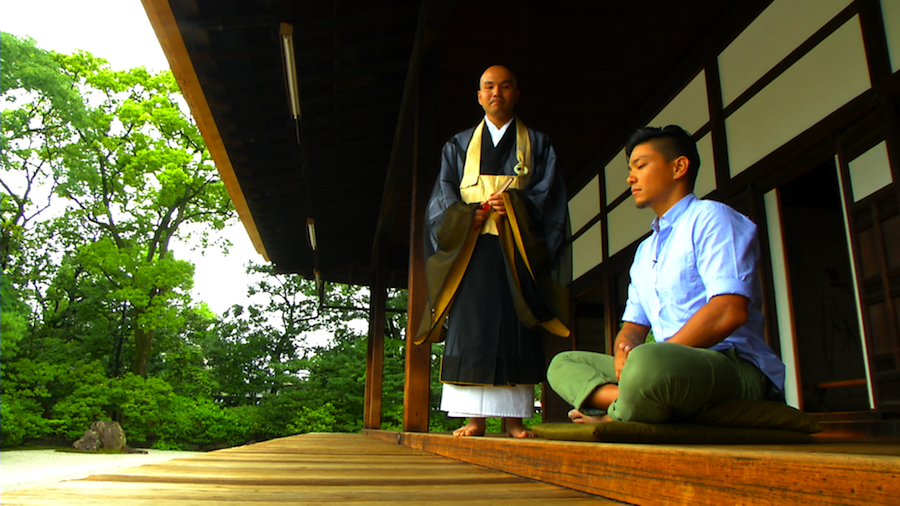Filtered by: Newstv
NewsTV
Japan: Making history live in the now
Whenever you hear the word "Japan," what image comes to your mind? One is a white flag with a red dot in the middle. If you're a child at heart, you might remember the countless anime series you've watched and mangas you've read. You might even think of Hello Kitty. Another image would be a bowl of ramen with a rich scent that fills the air.

When "Biyahe ni Drew" went to Japan for its two-part special, the country proved that it is more than its delicious cuisine and notable animated characters. Japan pays a lot of attention to its history and culture and they make sure that the rest of the world gets the chance to experience it as well.
Temple Run

Drew tries mind meditation at Kenninji Temple, the oldest Zen Buddhist temple in Kyoto | Photo: Alan Ebora
Kyoto was the old capital of Japan before Tokyo took its place. It is known as the "City of Ten Thousand Shrines" because of the many temples and shrines that were built during early times. These structures withstood the wrath that wars and fires brought, and they were preserved and well-taken care of until today.
Although it's a place of countless shrines and temples, Kyoto still maintains a balance with modern times. The Kyoto Station is one of the country's largest buildings. This 15-story building is a seat of convenience as it houses a shopping mall, a hotel, a movie theater, a department store, and several government facilities.
Memoirs of a geisha?

Kyoto is the only place where the strict geisha training still continues. | Photo: Alan Ebora
In Gion Corner, one would have the chance to witness performing arts –– traditional Japanese style. In earlier times, watching a geisha performance is a privilege given to those who belong to the upper class of the Japanese society. Now, geisha performances can be witnessed by anyone and tourists are even offered lower prices to see the shows! If that's not enough, one could even rent a kimono and be a geisha for a few hours.
Cosplay time

Tourists can freely walk around Toei Kyoto Studio Park, where Japanese period dramas are filmed | Photo: Alan Ebora
Toei Kyoto Studio Park is another famous destination. This is the place where different Japanese period movies and dramas are filmed. The studio park gives tourists the freedom to dress up as a ninja, a geisha, or a samurai, and feel as if they're part of a movie shoot.

Drew and the team clad in their samurai costumes! | Photo: Alan Ebora
Ninja moves
In the prefecture of Shiga lies the city of Koka. This city is known for its Ninja Village where everything ninja-related can be found –– a house with trapdoors and hidden compartments, a shuriken throwing range, a 9-stage obstacle course, and a museum of manuals and tools.

How are your shuriken-throwing skills, Ninja Drew? | Photo: Alan Ebora
It is good to note that despite the technological advancement that the country is going through, remote and rural places like Koka are still treated as gems.
Japanese royalty

The golden dolphins or kinshachi atop the Nagoya Castle symbolize the feudal lord’s authority. | Photo: Alan Ebora
Before, the Nagoya Castle is where the emperor or shogun of Japan lives and does his duties. During the World War II, the fires destroyed parts of the castle, including the golden dolphins or kinshachi that adorn the roof. In 1959, the golden dolphins were restored.
When Drew and the team visited the Nagoya castle, they were greeted by a construction site. The place is in the process of restoring an area destroyed by the second world war. Years have passed but the importance that the Japanese give to their historical structures is something to be admired.
Here are some behind-the-scenes photos from the shoot:

Due to the many attractions in the The Land of the Rising Sun, the "Biyahe ni Drew" Team surely enjoyed their visit!
Despite being one of the more advanced countries in the world, the Japanese give a high level of importance to their past. With Japan’s rich history, one would never run out of things to discover. Tourists are encouraged to experience Japanese culture as it is much more fun and enlightening than just learning about it in books and lectures.
Photos from “Biyahe ni Drew” segment producer Alan Ebora
Graphics by Francis Almario
–– Elise Maog/ARP
Find out your candidates' profile
Find the latest news
Find out individual candidate platforms
Choose your candidates and print out your selection.
Voter Demographics
More Videos
Most Popular





